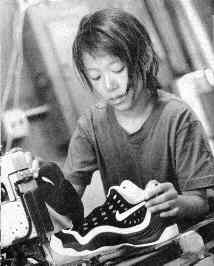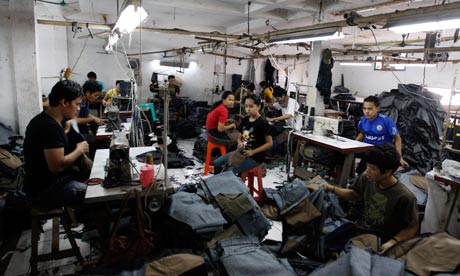
Sweatshops are clothing factories where workers (mostly women):
- get a very low wage
- have to work long hours
- work in poor, often dangerous, conditions
- are treated badly by their employers
- are not allowed to speak out or join a trade union.

 So should we stop buying (boycott) clothes from companies that use sweatshops? The problem is that this could actually hurt the workers we want to help. If a boycott succeeds and less people buy clothes made in sweatshops, workers will be laid off. Instead, campaigners in the UK are trying to create links between trade unions in different countries with the aim of ensuring that everyone has the right to expect reasonable working conditions.
So should we stop buying (boycott) clothes from companies that use sweatshops? The problem is that this could actually hurt the workers we want to help. If a boycott succeeds and less people buy clothes made in sweatshops, workers will be laid off. Instead, campaigners in the UK are trying to create links between trade unions in different countries with the aim of ensuring that everyone has the right to expect reasonable working conditions.
Millions of workers around the world suffer poverty wages and exploitation, producing cheap fashion for our shops
 Children like this young girl are prized in the carpet industry for their small, fast fingers. Defenceless, they do what they're told, toiling in cramped, dark, airless village huts from sunrise until well into the night.
Children like this young girl are prized in the carpet industry for their small, fast fingers. Defenceless, they do what they're told, toiling in cramped, dark, airless village huts from sunrise until well into the night. The International Labour Organisation (ILO) has estimated that 250 million children between the ages of five and fourteen work in developing countries. 61% in Asia, 32% in Africa and 7% in Latin America. Many of these children are forced to work. They are denied an education and a normal childhood. Some are confined and beaten. Some are denied the right to leave the workplace and go home to their families. Some are even abducted and forced to work.
The International Labour Organisation (ILO) has estimated that 250 million children between the ages of five and fourteen work in developing countries. 61% in Asia, 32% in Africa and 7% in Latin America. Many of these children are forced to work. They are denied an education and a normal childhood. Some are confined and beaten. Some are denied the right to leave the workplace and go home to their families. Some are even abducted and forced to work.NEWS
Sweatshops are still supplying high street brands
More than a decade after sweatshop labour for top brands became a mainstream issue, the problem still seems endemic across the global clothing and footwear sector

Indonesian labourers work at a garment factory in Jakarta. A report says that not one of the factories it surveyed in the country paid a living wage. Photograph: Mast Irham/EPA
Marks and Spencer's, Next, Ralph Lauren, DKNY, GAP, Converse, Banana Republic, Land's End, Levi's. And so the list of brands go on and on.
What do they all have in common? According to a deeply depressing report (pdf) by the International Textile Garment and Leather Workers' Federation (ITGLWF), the factories in Asia contracted to make their products are still responsible for shocking working practises.More than a decade after sweatshop labour for high street brands became a mainstream issue, and after plenty of companies have instituted monitoring of their supply chains, the problem still seems endemic right across the global clothing and footwear sector.
Many of the factories supplying the brands likely to dominate the Olympics in 2012, such as Adidas, Nike, Slazenger, Speedo and Puma, "are routinely breaking every rule in the book when it comes to labour rights", according to the ITGLWF.
The list of brands ultimately sourcing from the 83 factories surveyed in the report is so comprehensive, it seems to make a mockery of the whole idea that the high street has cleaned up its act.
Factories in three countries – the Philippines, Indonesia and Sri Lanka – were surveyed, and not one of them paid a living wage to their combined 100,000-strong workforce. Many of them didn't even pay the legal minimum wage. What the report also makes clear is that this is a gender issue: 76% of the surveyed workforce are women. Globalised supply chains exploit predominantly female labour. It's an irony that probably escapes most of the women who do the bulk of high street shopping in the west. Women shopping for products made by other, underpaid, exploited, women.
What's more, things seem to be getting worse, rather than better. Employment is becoming more precarious as more workers are put on to temporary contracts, day labour, on call rather than with permanent jobs. That enables employers to dodge holiday pay, sick pay and written contracts. Employers also imposed compulsory overtime, lower wages and higher production targets on workers on these short-term contracts.
Such precarious employment makes it harder for trade unions to organise and recruit, because contracts are not renewed if the worker has been involved in trade union activity. On average, 25% of workers in Indonesia were short-term or temporary, while in the Philippines it rose to 85% in one factory, 50% at another.
In Sri Lanka, wages were paid on productivity targets – despite such a practice being illegal. At one factory in Girigara, basic pay was cut if targets set by the management were not achieved. At another factory owned by the same company in Katunayake, workers didn't receive any incentive pay unless the entire quota was reached, but workers reported that the targets were impossible to meet so they never got their bonuses, even if they missed toilet breaks and rest periods to try and reach the target. At other factories, workers were forced to work overtime to meet productivity targets.
The report found that excessive overtime was the "norm" in sportswear and leisurewear factories in Indonesia; workers in all the factories surveyed were doing between 10 and 40 hours of overtime a week. There were incidents of mental and physical abuse when workers failed to reach production targets – in one factory, 40 workers were locked in an unventilated room without access to toilet facilities, water and food for over three hours as a punishment.
In Sri Lanka, workers were forced to work up to 130 hours per month in overtime, and anyone asking to leave would be verbally harassed. In the Philippines, 24% of workers said that they did not receive additional pay for their overtime. Typical hours can be 6am to 8pm.
Many of the workers at these factories in Sri Lanka are young women from rural areas. They are told when recruited that the factories prefer them not to marry, and some companies even carry out pregnancy tests to weed out pregnant women. Sexual intimidation and abuse was common.
In many cases, the employers' behaviour was illegal, but the report – which picked factories at random – points out that what makes laws effective is a well resourced inspection regime. Without inspection, legislation is meaningless.
It's worth adding at the end of this catalogue of abuse that the UK Department for International Development (DfID) has just axed funding to the International Labour Organisation, one of the oldest international bodies in the world trying to improve labour standards. The ILO brings out a report on Friday in conjunction with the Asian Development Bank on women's employment patterns across Asia and inequality
Looking on the web I found that these shops and brands have been found to use sweatshops

|
All kind of products can be made in sweatshops.
Some of the biggest problem industries are:
- Shoes
Many types of shoes are made in sweatshops. However, the biggest problem is found with sneakers and athletic shoes.
Most athletic shoes are made in sweatshops in Asian countries.
Child labour is also very common in the shoe industry. - Clothing
Clothing is very often made in sweatshops and with the use of child labour.
In the U.S. the majority of garment workers are immigrant women that work 60-80 hours a week, usually without minimum wage or overtime pay. Overseas, garment workers routinely make less than a living wage, working under extremely oppressive conditions. Rugs A lot of child labour is used in the rug industry. Nearly one million children are illegally employed making hand-knotted rugs worldwide.
Approximately 75% of Pakistan's carpet weavers are girls under 14. - Toys
A lot of toys are made in sweatshops and by child labour. Especially toys made in countries like China, Malaysia, Thailand or Vietnam. The average North American toy maker earns $11 an hour. In China, toy workers earn an average of 30 cents an hour. - Chocolate
43% of cocoa beans come from the Ivory Coast where recent investigators have found child slavery. In addition, cocoa workers who are paid, receive wages that leave them at the edge of poverty and starvation. - Bananas
Banana workers are some of the most exploited workers in the world. They have to work long hours, get low pay, are forced overtime and are exposed to dangerous pesticides. - Coffee
Coffee is the second largest US import after oil.
Many small coffee farmers receive prices for their coffee that are less than the cost of production, forcing them into a cycle of poverty and debt.

News found on the web about sweatshops today
http://www.vogue.co.uk/news/2013/04/04/zara-faces-sweatshop-allegations-in-argentina
http://en.wikipedia.org/wiki/Nike_sweatshops
http://www.dailymail.co.uk/news/article-2103798/Revealed-Inside-Apples-Chinese-sweatshop-factory-workers-paid-just-1-12-hour.html
http://www.dailymail.co.uk/news/article-2014325/Nike-workers-kicked-slapped-verbally-abused-factories-making-Converse-line-Indonesia.html
http://www.organicconsumers.org/articles/article_793.cfm
http://www.just-style.com/news/investigation-uncovers-british-sweatshops_id109447.aspx
http://marktiddy.co.uk/post/36132104590/dispatches-sweat-shops (thought this was interesting)
http://robertnielsen21.wordpress.com/2013/01/10/boycott-coca-cola/
|

.jpg)